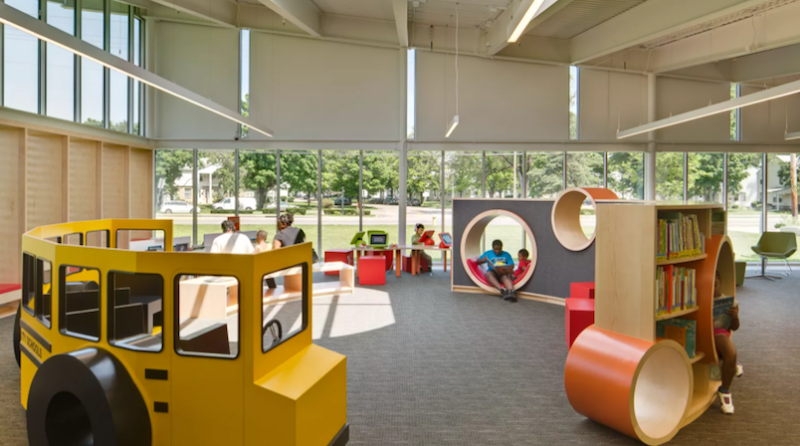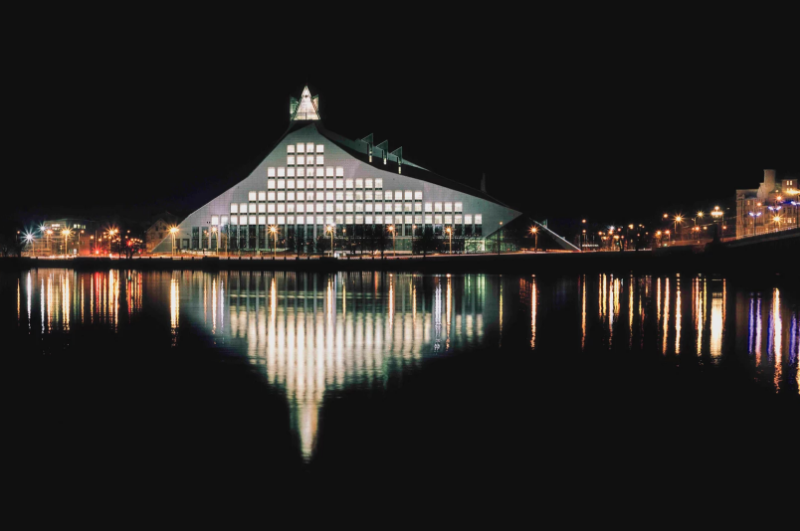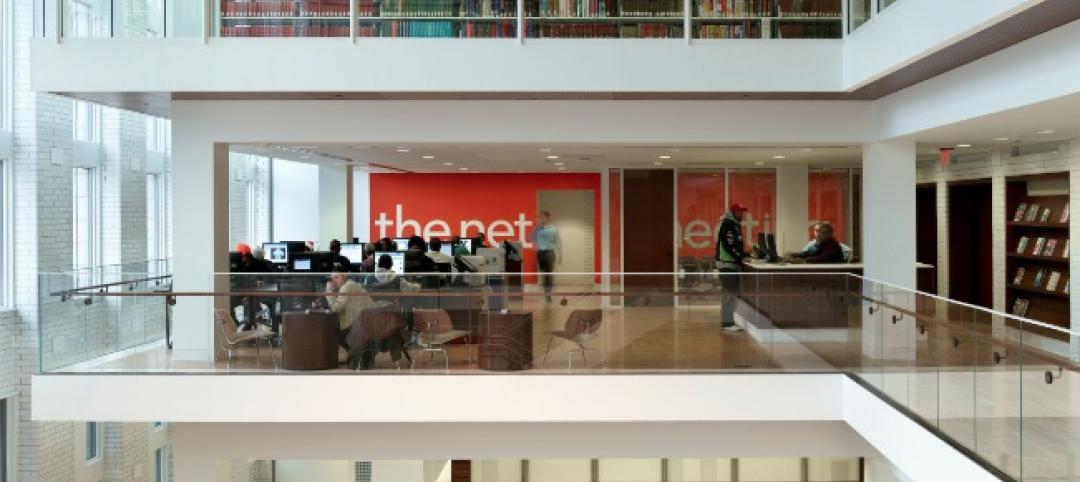The American Institute of Architects (AIA) and the American Library Association (ALA) selected eight recipients to receive the 2017 AIA/ALA Library Building Awards. The AIA and the ALA developed this award program to encourage and recognize excellence in the architectural design of libraries. As the traditional role of libraries evolves, the designs of these community spaces have changed to reflect the needs of the surrounding residence, as represented by the recipients of the AIA/ALA Library Building Awards. Click the project names to view additional information and images.
Boston Public Library, Central Library Renovation; Boston
William Rawn Associates, Architects, Inc.
 Photo: Robert Benson Photography.
Photo: Robert Benson Photography.
The renovation of this 156,000-square-foot civic monument provides immersive and engaging learning experiences for patrons inside as well as pedestrians who pass by. Originally constructed in 1895, this renovation has dramatically transformed a wing of the library from a solid stone bunker to an inviting light-filled space that spills out into a newly defined public plaza. The interior space was carefully reconsidered through the lens of a 21st-century patron to address the needs of all visitors, from pre-readers to adults. To further serve as a hub for education and innovation, the library boasts a range of spaces for both formal and informal convening. A 340-seat auditorium, open space for performances, and a conference center have helped increase public interest and the free flow of ideas. The greatest benefit to patrons, however, is the much more fluid connection between both wings of the library.
Columbus Metropolitan Library – Whitehall; Columbus, Ohio
JBAD
 Photo: Brad Feinknopf
Photo: Brad Feinknopf
Surrounded by lawns, meadows, and planting beds, the library’s façades are clad in metal panels complemented by storefront glazing with varying levels of transparency—greater in public areas and less in staff and support areas. The simple configuration, flooded by reading-friendly northern light, provides maximum flexibility for the rapidly changing needs of modern libraries. Having achieved LEED Silver certification, the library’s sustainable strategies can be noted throughout. Interior fins and external louvers on the library’s west-facing glass control heat gain while still providing quality reading light, and advanced HVAC systems in the public areas provide service from only the perimeter, allowing easy accommodation of new technologies and future opportunities. Further adding to the library’s arsenal of teaching tools, a series of LED screens displays the structure’s energy performance in real time.
East Boston Branch Library; Boston
William Rawn Associates, Architects, Inc.
 Photo: RobertBensonPhotography
Photo: RobertBensonPhotography
With its glass façades overlooking the 18-acre park that emerged from the city’s Big Dig project, the new library boasts an airy column-free reading room with dedicated areas for adults, teens, and children. The open plan allows families to visit together and not be corralled into separate rooms, while clear sightlines maximize staffing efficiency. Shelving on casters lends extra flexibility, allowing librarians to curate the collections over time and adapt to the evolving needs of a modern library. Capping the library is an undulating roof that admits ample daylight to fill wood-wrapped common areas. The site was a former brownfield and, beyond its transformation into a civic hub, the library has a number of sustainable features. In addition to high-performance mechanical systems and proximity to mass transit, a stormwater garden greets visitors at the sidewalk, with signage describing its role in promoting the health of Boston Harbor. Overshooting the city’s target of Silver, the new library received LEED Gold certification.
National Library of Latvia; Riga, Latvia
Gunnar Birkerts Architects; Associate Architect: Gelzis-Smits/Arhetips
 Photo: Indriķis Stūrmanis
Photo: Indriķis Stūrmanis
The new library, at nearly 600,000 square feet is situated at the terminus of a bridge spanning the River Daugava. It was envisioned as a place to store, preserve, and make accessible the country’s cultural heritage. To that end, it is supported by state-of-the-art technology that allows for easy digitization and safe storage. The library’s form dovetails with functionality by accommodating the various collections areas. Presented in vertical arrays in appropriately sized spaces, they all connect to the central stack core. A full wall display of books donated by Latvians as a symbolic gesture soars through the atrium and teases the massive adjacent stack area. The atrium itself, with its central stair, provides connectivity to all the public levels and serves as a unifying element that illustrates the library’s logical organization and circulation.
New York Public Library Stapleton Branch Renovation and Expansion; New York City
Andrew Berman Architect, PLLC
 Photo: Naho Kubota
Photo: Naho Kubota
Expanding from a single-room Carnegie branch library that had served Stapleton, Staten Island, for a century, this project has created a new 12,000-square-foot library that better serves the community. Open, inviting, and accessible, the project stitches together new and old buildings, and provides equal space for tactile and digital learning opportunities. Restored to its original design, the existing Carnegie library now houses the children’s area, while the expansion on the other side of a transparent community room contains teen and adult reading areas and research facilities. The library’s exposed-wood structure provides rhythm and richness, while the glazed façade supplies natural light and invites participation. Additional natural light comes courtesy of multiple framed skylights, and the variegated surfaces of the roof and façade diffuse and deflect sound waves to soften the acoustics of the open plan.
Rosa F. Keller Library and Community Center; New Orleans
Eskew+Dumez+Ripple
 Photo: Timothy Hursley
Photo: Timothy Hursley
Funded entirely through the Federal Emergency Management Agency’s recovery program, the project involved the restoration of a 1917 Arts and Crafts bungalow that serves as a community center and reconstruction of an adjacent 6,300-square-foot library wing. Together, the new library and restored community center provide the neighborhood with an innovative 21st-century facility that offers ample opportunities to engage with technology and alternative educational outreach programs. The project has achieved LEED Silver certification, with all its aspects bearing hallmarks of sensitive community engagement. Key programmatic elements—evident in the catering kitchen and café—reference the importance of culture as the driving force that helps communities recover from disaster. With food and its preparation playing a pivotal role in the lives of so many Louisianans, the adjacency of food and words is the perfect match for a very New Orleans–style approach to sustainability.
University of Oregon Allan Price Science Commons & Research Library Remodel / Expansion; Eugene, Ore.
Opsis Architecture LLP
 Photo: Christian Columbres
Photo: Christian Columbres
Guided by feedback provided by the University of Oregon’s student body, this project included a complete renovation and addition to an existing underground library. Atop an 48,000-square-foot underground library, the project added 4,000 square feet of new space. Occupying a difficult site wedged between two buildings, sub-floor-to-high-ceiling windows illuminate the commons space with natural light. A new entry pavilion supplements a brutalist courtyard that exacerbated the subterranean conditions of the existing library and maximizes available light below. A wood curtainwall sprouts organically in the courtyard, creating a calming forest atmosphere that completes the expression of light and nature. Students and faculty have enjoyed the variety of spaces, with some students remarking that they had forgotten they were underground since the space no longer feels like a basement.
Varina Area Library; Henrico, Va.
BCWH, Associate Architect: Tappe Architects
 Photo: Chris Cunningham Photography
Photo: Chris Cunningham Photography
Firmly rooted in its natural environment, the library’s design was inspired by the community’s vernacular. With a series of pavilions that emerge and cascade down the landscape, the design’s simple palette and forms evoke an assemblage of tobacco barns. Inside, the new library provides countless opportunities for patrons to engage with the collections and the staff. The client and the design team worked hand in hand to develop an intuitive floor plan that maximizes views of the natural setting, further amplified by a back porch–style overlook in the rear of each pavilion. To provide easy access for its nearly 300,000 cardholders, the library’s configuration allows for quick transactions when needed. Following that directive allowed the team to consolidate programming and take a balanced approach to open day-lit spaces and enclosed quiet spaces, and to increase efficiency in the mechanical systems and ductwork runs.
Related Stories
| Nov 15, 2013
Greenbuild 2013 Report - BD+C Exclusive
The BD+C editorial team brings you this special report on the latest green building trends across nine key market sectors.
| Nov 13, 2013
Installed capacity of geothermal heat pumps to grow by 150% by 2020, says study
The worldwide installed capacity of GHP systems will reach 127.4 gigawatts-thermal over the next seven years, growth of nearly 150%, according to a recent report from Navigant Research.
| Oct 30, 2013
11 hot BIM/VDC topics for 2013
If you like to geek out on building information modeling and virtual design and construction, you should enjoy this overview of the top BIM/VDC topics.
| Oct 28, 2013
Urban growth doesn’t have to destroy nature—it can work with it
Our collective desire to live in cities has never been stronger. According to the World Health Organization, 60% of the world’s population will live in a city by 2030. As urban populations swell, what people demand from their cities is evolving.
| Oct 23, 2013
Gehry, Foster join Battersea Power Station redevelopment
Norman Foster and Frank Gehry have been selected to design a retail section within the £8 billion redevelopment of Battersea Power Station in London.
| Oct 18, 2013
Researchers discover tension-fusing properties of metal
When a group of MIT researchers recently discovered that stress can cause metal alloy to fuse rather than break apart, they assumed it must be a mistake. It wasn't. The surprising finding could lead to self-healing materials that repair early damage before it has a chance to spread.
| Oct 15, 2013
Cass Gilbert's landmark St. Louis Central Library gets a reboot
A $70 million project returns large sections of the building to their original Beaux Arts beauty, while modernizing the spaces to make them more inviting and useful for today’s patrons.
| Sep 19, 2013
What we can learn from the world’s greenest buildings
Renowned green building author, Jerry Yudelson, offers five valuable lessons for designers, contractors, and building owners, based on a study of 55 high-performance projects from around the world.
| Sep 19, 2013
6 emerging energy-management glazing technologies
Phase-change materials, electrochromic glass, and building-integrated PVs are among the breakthrough glazing technologies that are taking energy performance to a new level.
| Sep 19, 2013
Roof renovation tips: Making the choice between overlayment and tear-off
When embarking upon a roofing renovation project, one of the first decisions for the Building Team is whether to tear off and replace the existing roof or to overlay the new roof right on top of the old one. Roofing experts offer guidance on making this assessment.

















